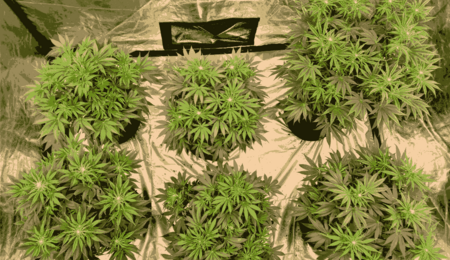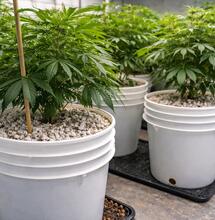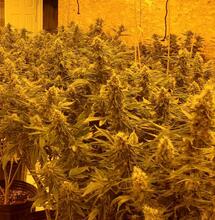The Art of Selection and Why Phenotypes Are Important

Cannabis plants are extremely diverse and capable of expressing many traits and phenotypes. If you imagine a strain as a genetic pool ready to be unlocked, all the various different plants that may be produced are already inside. In this article, we explain all you need to know about Cannabis phenotypes, what they are, why they are important, a list of all the desirable traits you may be looking out for, and our top tips to consider.
What does the selection process mean?
If you are new to growing Cannabis indoors and have so far planted your seeds or clones, vegetated them under 18/6, and then flowered them out without taking any clones, then this article is ideal for you. The selection process simply refers to choosing which of the plants inside your grow room are the best in terms of desirable traits.
For example, imagine starting with 20 regular-sized seeds. From this plant count, you will most likely grow up to 10 males, leaving behind 10 potential female keeper plants. Over the duration of the vegetative and flowering stages, you will get to see the plants perform while having a personal preference for which plants are most desirable to you as well as most practical.
- You can take clones during the vegetative and early flowering stage.
- Revegging the plants after harvest and growing them back is an option.
- You can make selections from 10 to 100 seeds if you have the time and space.
- Selection is essential for breeding projects and having a set goal in mind.
- Keeper phenotypes become mother plants and are then kept alive under 18/6.
- A mother plant is what produces the clones of the selected phenotype.
So what are Cannabis plant phenotypes?
Now that you are left with 10 females, there is a high chance you will see a wide array of phenotypes being expressed. This simply means that traits from both parents will show themselves as hybrid vigor and a mix of both parents, and in some cases, recessive traits from the grandparents. A good example of the phenotypes that you may find in Afghan Kush-crossed Haze #1 is explained below.
Phenotype #1: An Afghan Kush dominant phenotype with a 67-day flowering period. The aroma is gas and fuel, and the final plant height is 125 cm tall. The buds are golf ball-sized with a compact appearance. The effects are heavy-bodied and sleepy.
Phenotype #2: A Haze #1 dominant phenotype with an 84-day flowering period. The aroma is more lemon, citrus and sharp, with a final height of 180 cm . The bud structure is more airy, elongated and large . When smoking, the effects are energetic, racey and deeply creative.
Phenotype #3: A mixture of both Afghan Kush and Haze, flowering in just 70 days. The aroma is fruity, floral, citrusy, and gassy, and the final height is 140 cm . The bud structure is large , with a compact feel, and it is the best-yielding plant of the three phenotypes. The effects are uplifting and energetic, but over time, they become sleepy.
Understanding the different characteristics and traits
Cannabis plants are able to express themselves in so many different ways, allowing us as growers to focus on specific traits or phenotypes. It is important to know in advance what traits to look out for to make your selection process much easier, and to set a goal in advance.
Terpene profile
The aroma produced by the buds is due to the terpenes present in the trichomes. There are generally four groups of terpenes: fruit, floral, fuel and earthy.
Yield and production
How much flower the plant produces will relate to productivity and yield value. Everyone loves the idea of massively yielding phenotypes, however, there are many other traits that should be considered overly yielding.
The effects
When smoking the dried flower, how is the effect, and is it something that you or your friends personally enjoy? We are all different, and some of us like to be high and creative, while others enjoy being glued to the couch.
Flowering time
The number of weeks it takes for a certain plant to be fully finished can play a big role in the selection process. Many growers are often dubious about taking anything over the 70-day mark during 12/12 due to practical reasons.
Resin production
For many connoisseurs, the amount of resin produced by a plant can often indicate the level of quality. Some plants can become totally caked in resin, causing the leaves to taco and curl inward. Other phenotypes may only produce half the resin but smell special.
Hash-making and extracts
When you make hash or extracts, working with the most trichome-dense material is the key to success. Remember that what goes in is what comes out, so selecting phenotypes that will wash well and make cup-winning products is something to consider during the selection process.
Ability to clone
There is nothing more frustrating than a stubborn plant that does not want to clone or takes much longer than the others. How well a plant can clone, root and bounce back is important when choosing a keeper, especially on the breeding side of things.
Bud to leaf ratio
This simply refers to how much leaf there is compared to mature and dense buds. This is important for those who are yield-focused and do not like the idea of trimming too many leaves off once harvested. Not all strains produce the same bud-to-leaf ratio.
Internodal spacing
The space between each internode will determine how short or tall your plant will become. Indica Cannabis plants are popular for their short internal spacing and low final height. Sativa grow with long internodal spacing, a tall and bushy characteristic, and can finish very tall.
The stretch
This point can be especially important for home growers who may be limited by space. The stretch will play a role in how tall the plants grow come harvest time. The stretch occurs during weeks 1–3 and will cause plants to double or triple in size.
Growth structure
For those who are big into plant training and SCROG will be paying close attention to the growth structure. Plants which grow with an open, wide and bushy structure will often be the best candidates for training, and the best yielding plants.
Resilience and resistance
How tough your plants are is key to maintaining clones and mother plants. Some plants may seem weaker and more fragile compared to others, and are able to fight off mold or powdery mildew better than others. This trait is very important when growing outdoors.
3 top tips on selecting phenotypes
Top tip #1: Choosing the best-yielding plants may not always be the best option, as you will be neglecting all the other important traits such as effect, flavor, resin production and appearance. Our top tip here is to pick based on flavour, effect, and yield.
Top tip #2: Taking clones of the plants during the vegetative period of 18–6 will be the best window. Our top tip here is that you only need to take 1 or 2 clones for preservation's sake, as you will end up throwing out most of the clones later on.
Top tip #3: Once you have decided on the winning selection, turning your clone into a large-sized mother plant capable of producing hundreds of healthy clones every month is easy to do. Our top tip here is to keep the mother plant well-fed inside a large pot and provide a vegetative-friendly spectrum.
Our Conclusion
Pheno hunting is the most exciting stage for a home grower working with regular sexed or feminized seeds. Every single grower is different, and we all have our own preferences. The selection process is a fundamental part of breeding Cannabis and is the best way to allow gene pools to be truly opened and unlock new potential. For those who have never taken the time to hunt through a pack of seeds, then you are missing out, and we strongly recommend you start small and work your way up to large populations to find the true winning phenotypes.



